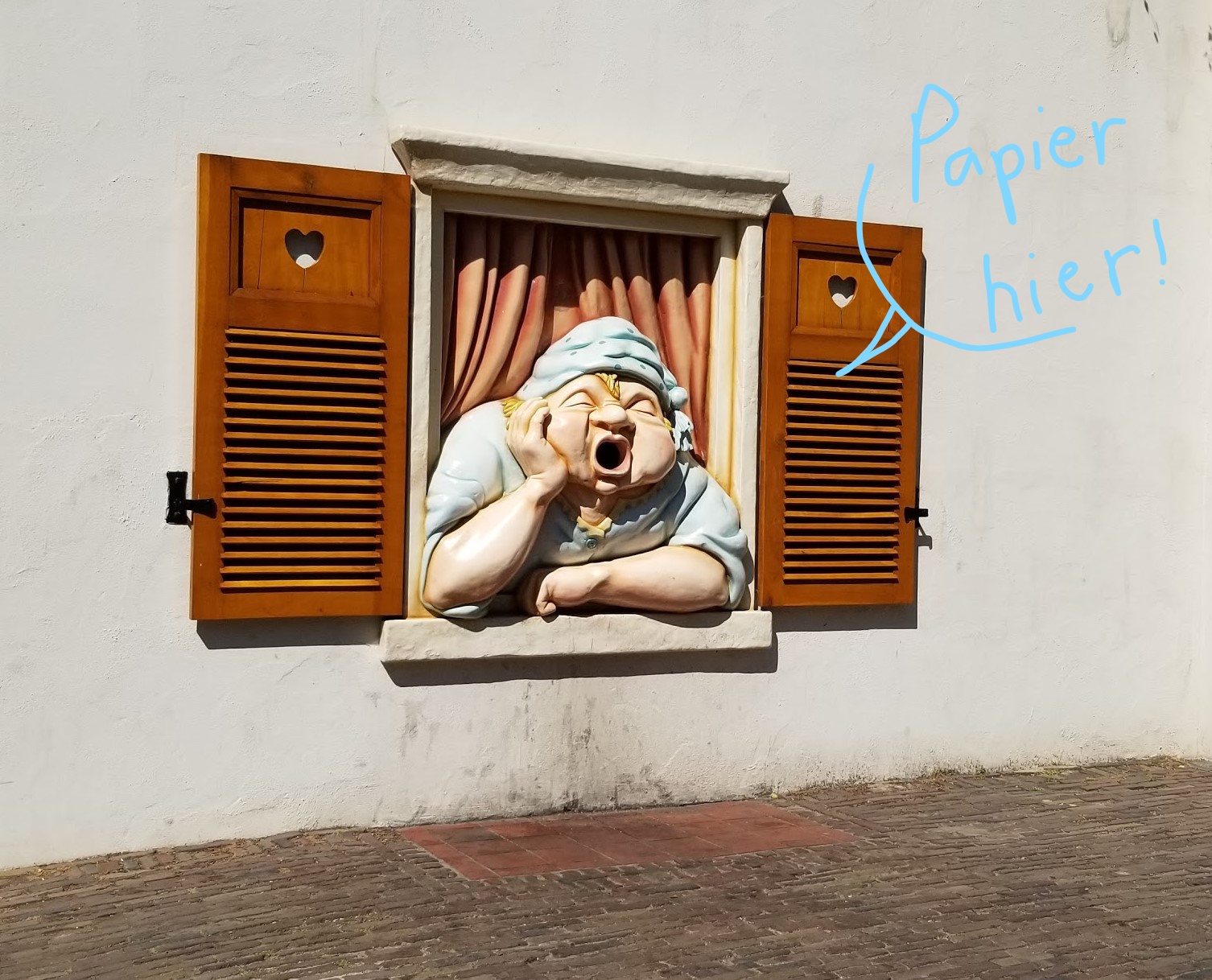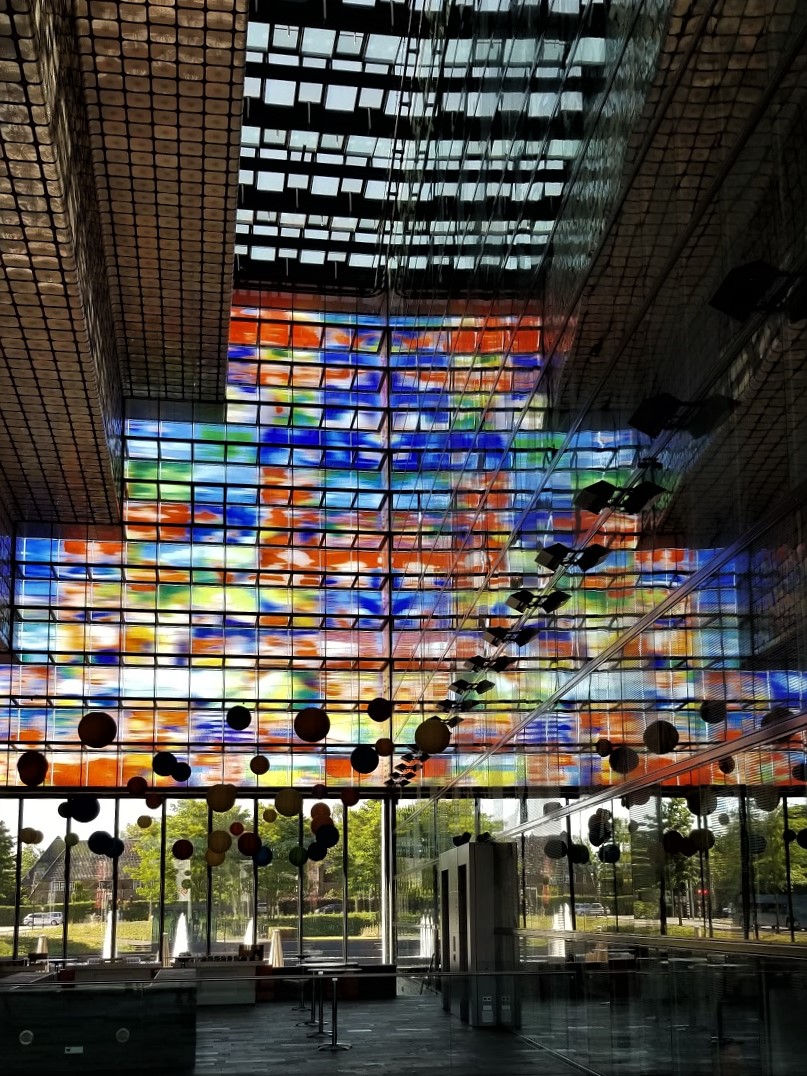The Impact of Place
Scott Bahlmann
The set designer wants to enhance an experience through the design of a space, and I’ll consider some of the decisions made at Efteling, which is an older but highly interactive experience, as well as the Institute of Sound and Vision in it’s more contemporary and environmental role. A key intention of set design is how it can affect emotions and efficiency, both key considerations for an amusement park. An archive/office space/museum might have less obvious needs, but Sound and Vision was very considerate in their design of space, beyond what might initially be expected.
Waiting in line is a large part of the amusement park experience. One of the differences I notices at Efteling is the division of the line when you get close to the ride. Sometimes the attendants would direct us, but for this dragon coaster we were encouraged to choose our team, water or fire. The coasters would run at the same time, and adding these teams connected the ride with the time spent in line.
The Hollander boat ride had a more atmospheric wait, with many elements connecting to the pirate theme. We could peek through broken slats to see pirate treasure, and walk through a torn painting. Not all of the rides had such immersive lines, but there was always some consideration given to extend the experience of the ride through the wait.
I really appreciated the way that common elements were designed to keep the magic of the experience. ATM’s were housed in over-sized treasure boxes and gramophones, rather than being placed in the side of a wall. Not only are they separate from other structures, making them clearly stand out, the ATM’s were almost secondary to the magical effect of their containers.
My favorite ‘hidden’ element were these trash receptacles. With a slight suction in their mouths, and a voice calling for paper, these were clearly designed to encourage a clean environment. One of our articles mentioned the visitors kids rushing around to look for trash to feed the figures. The suction wasn’t very strong and a paper cup, for example, blocked the input, but it’s very engaging.
Efteling was fantastic at incorporating nature into the park, and used what was naturally available in their considerations. The paths in the storybook area were made of small shells, rather than pebbles. For being near the sea, this is a great way to utilize local resources.
Many of the animatronics were fully constructed, but here is a sort of mask that was placed over an existing tree. Having an integration of the mechanical and nature makes the experience more magical, blurring the lines between reality and fantasy while utilizing what is already available in the park.
The institute of Sound and Vision used many subtle design element, which generate an emotional impact even if the details and intentions aren’t obvious to those visiting. Within the bright glass plates of the exterior are ridges of different depths, which create subtle images of archives shows. These are most easily seen in the lower part of this photo.
The colored glass panels connect the exterior and interior of the building, giving a cathedral effect. With subtle images on the right (the workspace) showing famous TV and radio personalities, and reflective tiles on the left for the museum, there is a clear division of space while retaining a harmonious central area.
The archives are set deep into the structure, integrating some of the brightness from the exterior with the solid orange against traditional stone textures. This relates to the age and tradition of the materials being stored while keeping a modern element.
Solid colors were consistent through the interior spaces, with the museum centered in a deep blue, and the work spaces utilizing a rich yellow. This monochrome execution unites the interior spaces while also keeping them distinct and providing an immediate emotional impact.
I also attended some dance performances that were meant to consider the ways body and place affect each other. Seeing how movement is designed in relation to a pre-existing space is a compelling flip on the set designers role. I’ll look at the way the ‘set design’ can be used to highlight an artistic message that wasn’t part of the architects intent.
The first piece I attended was A Question of Ma, choreographed by Amos Ben-Tal which took place at Pontsteiger. The audience sat on a floating pier which faces a small open courtyard where the dancers performed. The ‘windmills’ were developed in collaboration with interdisciplinary artist Gosse de Kort, and it seemed that the interactivity was less about the geographic location, and more the interaction with the specially constructed pieces. Even so, the reflective background of mirrors from the hotel expanded the performance, continuing the image of the spinning rods as well as the dancers. The musical accompaniment was simple, a rhythmic pulse that complexified slightly during the performance. I wondered if the pulsing water which separated the viewers from the performers was taken into consideration, but we didn’t have an opportunity to discuss the piece afterwards. From my own interpretation the artists drew from the cultural relation to windmills, though the title refers to the Japanese term for ‘gap’ or ‘pause’, which indicates that the piece may have been pre existing, and just adapted for this performance.
The Fool introduces us to the Post Office
Conversely, The Fool by Connor Schumacher was very integrated into the space, taking us around the building, having us touch and interact with it while he explained the way it impacted those that inhabited it. He set a context of the struggle between individuality and community, and how we draw straight rigid lines that are really made of soft curves. This metaphor was then extended to the seemingly hard surfaces of Museum Het Schip. We followed the front of the building to the integrated post office, and learned that it was a major shift for the community. Here was the first time the status symbol of sitting in public spaces was broken, and everyone was treated with equal consideration. It also took over the responsibility of dispersing paychecks, which had previously been a responsibility of taverns, and directly connected income with family and community rather than frivolity.
Drawing an even more direct connection to the community, we ended in the courtyard which hosted the Haard of Het Schip, the hearth, where the communal residents would gather for events. Their place for recovery. Here we were guided to raise our hands and walk forward mingling and shaking hands with each other. From our somewhat dispersed points of observations we ended in a solid circle around The Fool, and he highlighted how few places there are for people to just be, as we’d just done. It was an impactful reaffirmation of the importance of library spaces.












